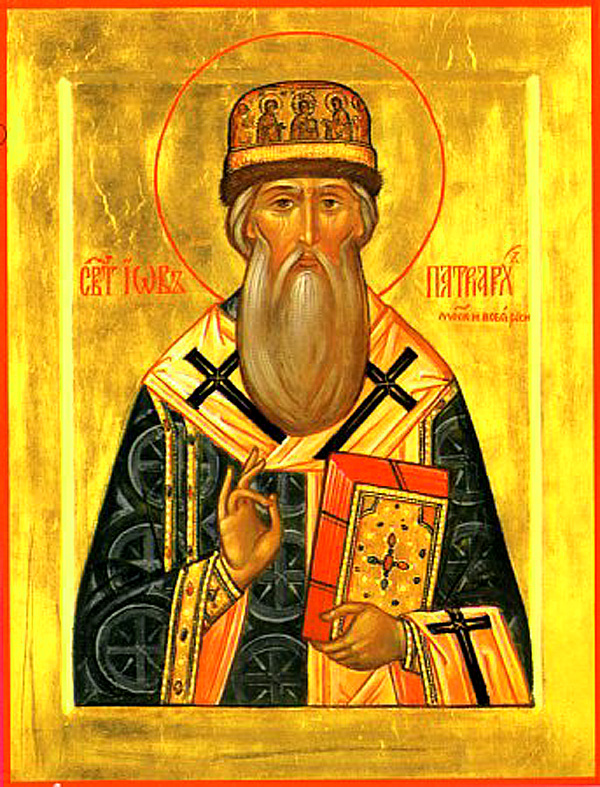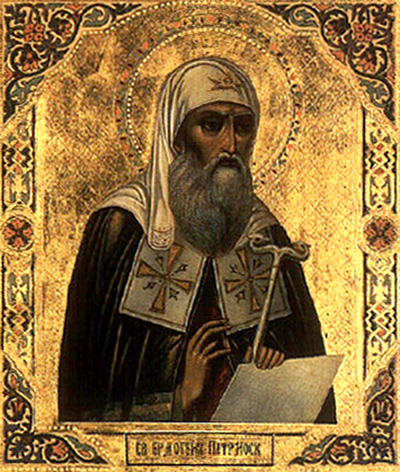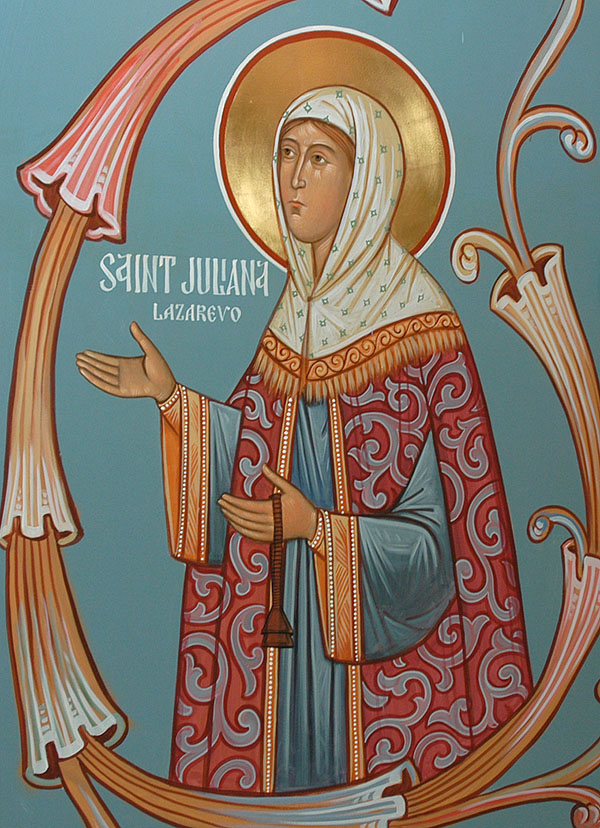Russia
The Time of Troubles

With the death of the saintly, slow-witted Tsar Theodore in 1598, the dynasty of the House of Rurik, which had ruled Russia since 860, came to an end. With the support of Saint Job, Patriarch of Moscow, a National Assembly elected Boris Godunov, Theodore’s brother-in-law who had acted as the chief administrator of the government during Theodore’s reign, as the new tsar.
Boris’s reign began well enough, but in 1601 a severe famine struck the land, accompanied by epidemics. His measures to alleviate the suffering were insufficient, and in the midst of the disorders, rumors began to spread throughout Russia that there was a male of the House of Rurik who was still alive. In 1591, the last heir, Tsarevich Dimitry, died under strange circumstances at the age of nine. Now, a young man claiming to be this Dimitry, and claiming to be the rightful heir to the throne, was gathering a following. He would become known as the “Pretender.”
As this false Dimitry began to pose a threat to Boris Godunov, the tsar panicked. He responded to this threat with a campaign of terror against real and imagined enemies in his own government—much as his mentor, Ivan IV, had done. In the midst of the struggle, he collapsed and died, in 1605.
Tsar Boris’s death paved the way for the imposter to take control of the government. After ruling for about a year, he was murdered in a coup d’état organized by a group of boyars (aristocrats) led by Basil Shuisky, who became the new tsar.
The Time of Troubles continued during Tsar Basil’s four-year rule, as a second False Dimitri arose and set up a rival government in the town of Tushino. Then the Poles and the Swedes invaded, intent on seizing as much territory as possible from the Russians in this moment of extreme weakness. Holy Trinity-Saint Sergius Monastery became the symbol of national resistance to the Western invaders, as this holy place endured a 16-month siege at the hands of the Polish army. Miraculously, the walled monastery withstood the siege, which included bombardment from 63 cannons.
At the height of the confusion and turmoil, Tsar Basil, deserted by his army and his allies after his forces were defeated by the Poles, was forced to abdicate, and the boyars formed a seven-man provisional government. Then, when the Poles captured Smolensk, the fortress city that guarded the road to Moscow, the terrified and self-serving boyars decided to capitulate to the Poles, in the hope of gaining privileges for themselves in return. In negotiations with Polish King Sigismund III, they selected a young son of King Sigismund, named Wladyslaw, as the new tsar, and opened the gates of the Kremlin to the Polish army.

Saint Patriarch Germogen (r. 1606–1612) was put under house arrest in the Kremlin by the Poles, but he was still able to send letters all across the nation urging the people to reclaim their homeland. For his efforts, the Poles starved him to death.
Energized by a vision of Saint Sergius of Radonezh, who urged him to take the lead in saving the nation, a wealthy butcher from Nizhni-Novgorod named Kuzma Minin organized a citizens’ army that drove the Poles out of Russia by the end of 1612. This brought to an end the stormy Time of Troubles.
Tsar Michael Romanov and
Patriarch Philaret (Romanov)
Early in 1613 in Moscow, sixteen-year-old Michael Romanov, a grandnephew of Tsar IV’s first wife, Anastasia Romanova, was elected to be the new tsar by the largest and most representative National Assembly ever held in Russia. This marked the beginning of the Romanov Dynasty, which ruled Russia until Tsar Nicholas II abdicated early in 1917. In 1619, Michael Romanov’s father, Philaret, who had been Metropolitan of Rostov, was made Patriarch of Moscow. Father and son ruled the tightening alliance of Church and State together.
The Nikonian Reforms
When Tsar Michael Romanov died in 1645, he was succeeded by his son, Alexis (r. 1645–1676), who was 16 when he took the throne. By now a new generation of reform-minded young priests had risen up who believed that spiritual revival would come through liturgical reform—including standardizing the various liturgical books, correcting various copying and translation errors, and celebrating the services whole and entire. In 1652, Tsar Alexis selected one of these energetic priests, the popular and talented—but forceful and rigorous—Nikon, Metropolitan of Novgorod, to be the new patriarch of Russia.
Along with most of the other reforming clergy, Nikon at first was a firm believer in Moscow as the Third Rome—as guardian of the full purity of the Orthodox Faith. But before becoming Metropolitan of Novgorod, Nikon had spent several years as abbot of an illustrious monastery in Moscow. It was in this time that he met several prelates from the Greek Church, especially Patriarch Paisius of Jerusalem, who visited Moscow from time to time seeking support from the Russian Church and State. These Greek churchmen helped him to see that it was very much in the interest of pan-Orthodox unity that the Russians bring their liturgical practices more closely in line with those of the Greek Church. This would also make the Russians more aware of the plight of the Greek Church suffering under the Turkish yoke, and hence more willing to come to their aid. Tsar Alexis strongly supported this program.
At the beginning of Great Lent in 1653, Patriarch Nikon began his reforms of church practices, bringing them into alignment with Greek practices. Among many other things, he issued injunctions that the sign of the cross must be made with three fingers instead of two, and that during Saint Ephraim’s Prayer, the sixteen full prostrations that the Russians were used to making must be changed to four full prostrations and twelve bows from the waist.
Archpriest Avvakum, another leader of the reform-minded clergy, along with many others, responded to the liturgical changes mandated by Patriarch Nikon with great consternation, even shock. For one thing, the two-fingered sign of the Cross had been confirmed by the great Stoglav Council of 1551 (the Council of the Hundred Chapters), with anathemas against any other practice. Also, the Russians were convinced that the Greeks were the ones who had departed from the pristine purity of the Faith—through their scandalous willingness to capitulate to Roman Catholicism at the Council of Lyons in 1274 and the Council of Florence in 1439. Besides this, the Russians were generally scandalized at the liturgical laxity demonstrated by the Greek churchmen visiting Moscow, who were not used to the very lengthy Russian services and the meticulous attention to liturgical detail observed reverently by the Russians. This added to the suspicions of Father Avvakum and his group.
In promoting the liturgical reforms, Nikon’s brash self-confidence led him to underestimate the opposition that his blunt, bludgeoning injunctions provoked. While the bulk of the people went along grudgingly with his demands, the reforming priests and their lay supporters declared, according to Nicolas Zernov, that “in no circumstances would they give up their belief in the superiority of Moscow tradition over that of other branches of the Eastern Church.”
This stubborn resistance to his plans infuriated Patriarch Nikon. He was staggered by this defiant disobedience to the Patriarchate. This provoked him to his second big mistake—trying to stamp out the dissent by force. The leading dissenters, according to Zernov, “were arrested, ill-treated, unfrocked, and sent into exile. All these measures were useless . . . persecution only inflamed their zeal and strengthened their conviction that Nikon was a traitor, a false shepherd, to be opposed to the end by all faithful Christians.”
Patriarch Nikon continued to promote his campaign for liturgical reform through the end of 1656. Then in January of 1657, Tsar Alexis returned from battles against the Poles to find Moscow seething with discontent against Patriarch Nikon. The Tsar cooled in his support of Nikon, ordering him to restore to communion one of the most out-spoken and prominent opponents of the reform, Father Ivan Neronov, who had been imprisoned in a monastery in 1653. Nikon obeyed, allowing him to use the old service books, and even saying, “Both are good. It doesn’t matter; use whichever books you wish.” From this point on, the Patriarch seemed to lose heart in the campaign for reform, turning to building new monasteries and churches.
Then, on July 10, 1658, Nikon uttered public complaints against the Tsar at the end of a divine liturgy, and announced his intention to retire from the Patriarchate, probably expecting the Tsar to rush to him to apologize. However, Tsar Alexis only sent two boyars to assure the patriarch of his continuing friendship.
The petulant Patriarch, unsatisfied with this response by the Tsar, remained true to his threat, and retired to a monastery, but without officially resigning from the Patriarchate. For eight years he played for time, neither resigning nor taking up his duties again.
Many consultations were held, including with various Eastern Patriarchs. Several councils were held, but still Nikon remained aloof, and the Church remained in a kind of limbo. Finally, in the Spring of 1666, Tsar Alexis summoned a major council of all the Russian bishops, which reaffirmed the new service books but did not condemn the old books as heretical. On this basis, many of the clergy who opposed the reforms accepted them. Those who still rejected them, such as Avvacum, were again anathematized. This council went on to address many of the concerns of all the reformers—matters of pastoral care, proper maintenance of the churches, proper records being kept, proper celebration of services (including yedinoglasno—only one voice being heard at a time), etc.
The Council of 1666–1667
However, the issue of the Patriarchate still remained unsettled. The Tsar felt that the presence of the other Orthodox Patriarchs was necessary to decide the issue. So he invited them all to come to Moscow for another council. Two of them came—Patriarch Paisius of Alexandria and Patriarch Makarios of Antioch. Once they arrived, the council began, in November of 1666.
The main figure at the council was the Metropolitan of Gaza, Paisius Ligarides. This man, who ironically had formerly been one of Nikon’s most ardent supporters, now turned fiercely against him, and was his chief accuser during this council.
The council addressed the issue of the Patriarchate first. After a month of deliberations, Nikon, the very man who instituted the reforms which this council was to endorse once and for all, was found guilty of unlawfully deserting the Patriarchal throne and showing great disrespect to the Tsar. He was deposed, defrocked, and confined to a monastery 350 miles north of Moscow, and a new patriarch was elected—Joasaph II. Nikon’s ignominious fall helped to make possible the fall of the Patriarchate itself in the time of Tsar Peter the Great.
Second, the revered Council of Moscow of 1551 (the Stoglav) was officially renounced, since that council had declared the Russian Church to be the standard and pattern for all of worldwide Orthodoxy. According to Zernov, “Hard pressed by the arguments of Metropolitan Paisius of Gaza, the Russian bishops reluctantly signed the following statement: ‘We declare the Council of 1551 to be no Council at all, and its decisions not binding, because the Metropolitan, Makary, and those with him acted and made their decisions in ignorance, without reason, and quite arbitrarily, for they had not consulted the Ecumenical Patriarch.’” This Metropolitan Makary was canonized as a saint in 1988 by the Russian Church.
Third, contemporary Greek liturgical practices were affirmed, and the old Russian practices in disagreement with the Greek usages were condemned as heretical. Ironically, this was in direct opposition to a letter sent by Patriarch Paisius of Constantinople and 28 other Greek bishops to Moscow in 1655.
And fourth, all those refusing to accept the liturgical reforms were not only anathematized, but handed over to the secular authorities for punishment as heretics.
The Old Believer Schism
True to their word, Avvakum and his group of dissenters refused to obey the dictates of this council, and the Old Believer Schism became a deep and bitter reality, lasting to the present day. During the time of Tsar Peter the Great (r. 1689–1725), whom many of the Old Believers considered to be Antichrist, up to one-third of all Russian Orthodox Christians—many of them among the most pious, most dedicated Christians in the land—were associated with the Old Believer movement.
Avvakum was sent into exile in the north of Russia. In 1682 he was burned alive, along with three of his closest associates, on the charge of blasphemies uttered against the Tsar and his household. Many other Old Believers were persecuted by the Church and State, which only deepened their antagonism. In their desire to preserve pure and unchanged the rituals of the Russian Church of the mid-17th century, the Old Believers have succeeded in preserving ancient Russian forms of iconography and liturgical chant which otherwise would likely have been lost. Most of them have resisted all attempts at reconciliation ever since.
Russian Saints in the 17th century

Besides Saint Patriarch Germogen, the Russians’ heroic defense of their Faith and nation during and immediately after the Time of Troubles was epitomized by Saint Juliana Lazarevskaya (d. 1604), a housewife of the lower nobility who sacrificed herself and her possessions for the poor and needy; the resourceful Saint Dionysius, Abbot of the Holy Trinity-Saint Sergius Monastery; and Saint Dorothy of Kashin, a wealthy widow who restored and led as abbess the women’s monastery in her town. Later in the century, Saint Theodosius of Chernigov (d. 1696) was a particularly effective and beloved abbot of various monasteries before becoming Bishop of Chernigov. Saint Dmitry, Bishop of Rostov (d. 1709), compiled a vast collection of Saints’ Lives that is still the standard in the Russian Church.
